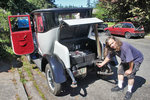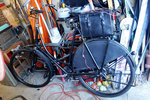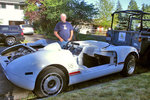The driveway and garage are filled to capacity with outlandish vehicles.
There is a low-slung bicycle with oversize wheels, a set of gleaming longhorns fronting immense ape-hanger handlebars, and …
This item is available in full to subscribers.
We have recently launched a new and improved website. To continue reading, you will need to either log into your subscriber account, or purchase a new subscription.
If you had an active account on our previous website, then you have an account here. Simply reset your password to regain access to your account.
If you did not have an account on our previous website, but are a current print subscriber, click here to set up your website account.
Otherwise, click here to view your options for subscribing.
* Having trouble? Call our circulation department at 360-385-2900, or email our support.
Please log in to continue |
|




The driveway and garage are filled to capacity with outlandish vehicles.
There is a low-slung bicycle with oversize wheels, a set of gleaming longhorns fronting immense ape-hanger handlebars, and tooled leather saddlebags, parked next to a lawnmower sporting a large solar panel.
The tiny red-and-blue golf cart with a “Chick Magnet” bumper sticker is next to a blue golf cart that looks like George Jetson’s futuristic flying cartoon car; next to them is a red electric muscle car whose patina of dust belies its drag-race champion status.
The man behind the machines is Roderick Wilde, executive director of the Historic Electric Vehicle Foundation (HEVF) and owner of Vintage Golf Cart Parts in Sequim.
Wilde grew up in Shelton, Washington, and started his career in machine trades there in 1967, as a journeyman aerospace machinist making parts for Boeing 727s and 747s. He worked all over the western states in machine shops, making prototype parts for nuclear reactors, machines that put labels on Campbell’s soup cans, a box-stacking machine and other contraptions.
Wilde, whose dad was the service manager at a Chrysler dealership, said he knew at an early age that “the future was in rotational motion, and internal combustion was just stupid.”
It’s basic physics, he said. In an internal combustion engine, the pistons have to come to a complete stop; it’s not efficient. In contrast, an electric motor just goes around and around, like the wheels it turns.
ELECTRIC DREAMS
Wilde and the HEVF, a nonprofit registered in Washington state, this summer loaned eight electric vehicles to the Powerhouse Visitor Center in Kingman, Arizona, for a temporary exhibit. It's already had visitors from 24 states and 13 countries, Wilde said, and may stay open a few years.
He has big plans for a much larger international museum of electric cars. Wilde wants it to happen here in Port Townsend, and his vision is extensive and specific; he wants it to be fully self-sustaining, generating its own electricity, and to have a large garden of fruits and vegetables for visitors to browse.
Also this summer, HEVF has applied and been approved for 501(c)(3) nonprofit status. They plan to launch a large crowdfunding campaign to get the museum off the ground.
“We have to raise millions,” he said. “My vision is a facility that’s totally sustainable.”
There are other electric car enthusiasts, some of whom want a museum to locate in their area.
“There is so much politics involved in this,” Wilde said.
A museum could showcase electric vehicles, and raise awareness and acceptance of electric vehicles.
Wilde’s collection includes a 1930 Detroit Electric, which looks sort of like an old Ford Model A, but instead of a steering wheel, it has two levers for power and steering. Bryan Wentzel of Port Townsend has done extensive restoration work on the wooden framework for the car's aluminum body.
"It's the first car in history to use curved glass," Wilde noted.
GROCERY GETTER
Wilde also has several electric microcars manufactured from the 1940s to the ’60s, including a sweet little car about the size of a smart car called an Electric Shopper, made by the Electric Car Co. of Long Beach, California, in 1960. It’s in mint condition and recently spent nine months at the Petersen Automotive Museum in Los Angeles.
“They’re not golf carts,” said Wilde’s friend Sam Maynard. “They’re grocery getters. That’s the proper term.” The car can carry two people and 10 bags of groceries; that’s what it was made for.
In late June, Wilde and Maynard took the Electric Shopper and the Detroit Electric to the Greenwood Car Show in Seattle, which had an “Electric Alley” that filled a whole block. The Detroit Electric, which has a red velvet interior, complete with dainty red curtains and two vases of flowers, won a few awards at the show. Like all electric cars, it’s virtually silent.
For the past two years, the Seattle Electric Vehicle Association (SEVA) has had the most cars of any single group at the Greenwood Car Show, according to its website, and you don’t have to be a motorhead to note the uptick in hybrids and other electric vehicles.
Wilde said that at the turn of the century, there were twice as many electric vehicles registered and licensed in the U.S. as gas-powered vehicles.
“They originally marketed electric cars for women,” he said. The hand-crank required to start old gas-powered cars was too difficult for ladies to operate.
Wilde recently acquired a 1995 Tropica, a low-slung, curvy, fast-looking car built in Sebring, Florida. Only 22 of them were ever made, and his is one of three prototypes made with four motors instead of the original two. His also has a rear differential taken out of a Corvette.
The Tropica “was in Car and Driver [magazine] in 1995,” he said. The company put Tropicas in showrooms around the country, trying to raise money for production.
Wilde is also one of the main founders of the National Electric Drag Racing Association
(nedra.com). There’s a red car in his driveway, mostly obscured by diverse objects and other vehicles. “It doesn’t look like much now,” he said, but it “blew away a V10 Dodge Viper” in 1998, with Ryan Seacrest riding shotgun.
Wilde also likes bicycles, he owns 20-30 electric bikes, including a 1901 shaft-drive rambler with wooden wheels and a 1940 Dutch Fongers bike that he found in a PT shed and fixed up. “Queen Wilhelmina had a 1939” Fongers, he said.
The Jefferson County resident of more than 30 years said that he’s “at that awkward stage between puberty and death,” and recently got himself a walker that he plans to soup up with an electric motor.
“I’m going to call it Johnny,” Wilde said. “I kind of invent stuff.”
His latest project is a motorized “chopper” bicycle with ape-hanger handlebars and an electric hub motor on the rear wheel; the batteries are hidden in the saddlebags.
Learn more at